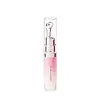What's inside
What's inside
 Key Ingredients
Key Ingredients

 Benefits
Benefits

 Concerns
Concerns

 Ingredients Side-by-side
Ingredients Side-by-side

Petrolatum
EmollientHydrogenated Polyisobutene
EmollientOctyldodecanol
EmollientPolyglyceryl-2 Triisostearate
EmulsifyingTriisostearyl Citrate
EmollientC10-30 Cholesterol/Lanosterol Esters
EmulsifyingAscorbyl Tetraisopalmitate
AntioxidantEthylene/Propylene/Styrene Copolymer
Ricinus Communis Seed Oil
MaskingSqualane
EmollientDipalmitoyl Hydroxyproline
Skin ConditioningSodium Hyaluronate
HumectantButyrospermum Parkii Butter
Skin ConditioningTocopherol
AntioxidantHydrogenated Castor Oil
EmollientPalmitoyl Tripeptide-1
Skin ConditioningCeramide NP
Skin ConditioningCeramide Ns
Skin ConditioningCeramide As
Skin ConditioningCeramide EOP
Skin ConditioningCeramide AP
Skin ConditioningParfum
MaskingButylene/Ethylene/Styrene Copolymer
Ethylhexyl Palmitate
EmollientDisodium EDTA
Tribehenin
EmollientSorbitan Isostearate
EmulsifyingPentaerythrityl Tetra-Di-T-Butyl Hydroxyhydrocinnamate
AntioxidantGlycerin
HumectantHydrogenated Lecithin
EmulsifyingPetrolatum, Hydrogenated Polyisobutene, Octyldodecanol, Polyglyceryl-2 Triisostearate, Triisostearyl Citrate, C10-30 Cholesterol/Lanosterol Esters, Ascorbyl Tetraisopalmitate, Ethylene/Propylene/Styrene Copolymer, Ricinus Communis Seed Oil, Squalane, Dipalmitoyl Hydroxyproline, Sodium Hyaluronate, Butyrospermum Parkii Butter, Tocopherol, Hydrogenated Castor Oil, Palmitoyl Tripeptide-1, Ceramide NP, Ceramide Ns, Ceramide As, Ceramide EOP, Ceramide AP, Parfum, Butylene/Ethylene/Styrene Copolymer, Ethylhexyl Palmitate, Disodium EDTA, Tribehenin, Sorbitan Isostearate, Pentaerythrityl Tetra-Di-T-Butyl Hydroxyhydrocinnamate, Glycerin, Hydrogenated Lecithin
Paraffinum Liquidum
EmollientPolyisobutene
Ethylhexyl Methoxycinnamate
UV AbsorberEthylhexyl Salicylate
UV AbsorberEthylene/Propylene/Styrene Copolymer
Butyrospermum Parkii Butter
Skin ConditioningHomosalate
Skin ConditioningBis-Ethylhexyloxyphenol Methoxyphenyl Triazine
Skin ConditioningAlcohol
AntimicrobialVp/Va Copolymer
Panthenol
Skin ConditioningWater
Skin ConditioningMacadamia Integrifolia Seed Oil
Skin ConditioningTocopheryl Acetate
AntioxidantBHT
AntioxidantParfum
MaskingSorbitan Olivate
EmulsifyingGlyceryl Stearate
EmollientButylene/Ethylene/Styrene Copolymer
Paraffinum Liquidum, Polyisobutene, Ethylhexyl Methoxycinnamate, Ethylhexyl Salicylate, Ethylene/Propylene/Styrene Copolymer, Butyrospermum Parkii Butter, Homosalate, Bis-Ethylhexyloxyphenol Methoxyphenyl Triazine, Alcohol, Vp/Va Copolymer, Panthenol, Water, Macadamia Integrifolia Seed Oil, Tocopheryl Acetate, BHT, Parfum, Sorbitan Olivate, Glyceryl Stearate, Butylene/Ethylene/Styrene Copolymer
 Reviews
Reviews

Ingredients Explained
These ingredients are found in both products.
Ingredients higher up in an ingredient list are typically present in a larger amount.
We don't have a description for Butylene/Ethylene/Styrene Copolymer yet.
This ingredient is also known as shea butter. It is an effective skin hydrator and emollient.
Emollients help soothe and soften your skin. It does this by creating a protective film on your skin. This barrier helps trap moisture and keeps your skin hydrated. Emollients may be effective at treating dry or itchy skin.
Shea butter is rich in antioxidants. Antioxidants help fight free-radicals, or molecules that may harm the body. It is also full of fatty acids including stearic acid and linoleic acid. These acids help replenish the skin and keep skin moisturized.
While Shea Butter has an SPF rating of about 3-4, it is not a sunscreen replacement.
Shea butter may not be fungal acne safe. We recommend speaking with a professional if you have any concerns.
Learn more about Butyrospermum Parkii ButterWe don't have a description for Ethylene/Propylene/Styrene Copolymer yet.
Parfum is a catch-all term for an ingredient or more that is used to give a scent to products.
Also called "fragrance", this ingredient can be a blend of hundreds of chemicals or plant oils. This means every product with "fragrance" or "parfum" in the ingredients list is a different mixture.
For instance, Habanolide is a proprietary trade name for a specific aroma chemical. When used as a fragrance ingredient in cosmetics, most aroma chemicals fall under the broad labeling category of “FRAGRANCE” or “PARFUM” according to EU and US regulations.
The term 'parfum' or 'fragrance' is not regulated in many countries. In many cases, it is up to the brand to define this term.
For instance, many brands choose to label themselves as "fragrance-free" because they are not using synthetic fragrances. However, their products may still contain ingredients such as essential oils that are considered a fragrance by INCI standards.
One example is Calendula flower extract. Calendula is an essential oil that still imparts a scent or 'fragrance'.
Depending on the blend, the ingredients in the mixture can cause allergies and sensitivities on the skin. Some ingredients that are known EU allergens include linalool and citronellol.
Parfum can also be used to mask or cover an unpleasant scent.
The bottom line is: not all fragrances/parfum/ingredients are created equally. If you are worried about fragrances, we recommend taking a closer look at an ingredient. And of course, we always recommend speaking with a professional.
Learn more about Parfum